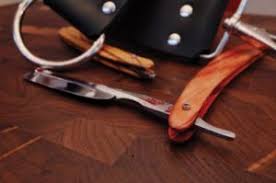In the garage of his Mill Creek home, Paul Macdonald draws a piece of 60-year-old German steel from a box of dull, dusty, rusty razor blades before polishing it on a buffing wheel to get an edge so thin, it’s white. He scrapes it back and forth across a leather strop covered in one micron of diamond paste, rolls up his sleeve and presses the blade to the back of his patchy, stubbled arm. “Getting them sharp is an art in itself,” he says, stripping clean yet another patch of hair.
The refurbished blade is now ready for one of Macdonald’s handcrafted scales – made from desert island, cocobolo, buckeye burl and other exotic woods – and will soon find its way to another hirsute gentleman reconnecting with his manliness. Along with satchels, pocket-watches and rockabilly hairdos, straight-razors are back – and the vintage trend has made an unexpected hit out of Macdonald’s hobby.
Jordan Fritz of Knifewear, the proud purveyor of premium sharp objects, explains the popularity as a move away from disposable culture. “Instead of buying disposable blades, a lot of men are getting a straight-razor, learning how to take care of it, and using it for 40 years.” Trendy barbershops like Barber Ha have made precarious straight-shaves a signature experience.
Macdonald, an occupational therapist, also found that regardless of how many “Machs,” or watts, plastic and electric razors just didn’t cut it. He bought a brand new straight-razor from eBay, but hated the plastic handle. A hobbyist woodworker, he crafted his own scale out of a smooth cocobolo. Then he made another. And another. Soon he was constructing a wood chest to hold all 80 blades, each engraved with his initial.
Macdonald auctioned a few on eBay for modest prices, but it was only when he stumbled into Knifewear that he realized the going price is upwards of $100. He returned later that day with a plastic bag of his refurbished razors. “They tried out 10 and, before you know it, they wanted 20 more.”
“The scales are nicer than anything I’d ever seen in terms of the woodworking,” says Fritz, “and his polishing job on the blades is really, really nice.”
